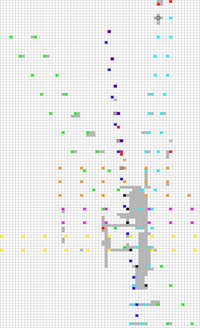The Wiki for Tale 4 is in read-only mode and is available for archival and reference purposes only. Please visit the current Tale 11 Wiki in the meantime.
If you have any issues with this Wiki, please post in #wiki-editing on Discord or contact Brad in-game.
Difference between revisions of "Limestone blocks"
| Line 18: | Line 18: | ||
== Blocks List == | == Blocks List == | ||
| − | |||
| − | |||
| − | |||
| − | |||
| − | |||
| − | |||
| − | |||
| − | |||
| − | |||
| − | |||
| − | |||
| − | |||
| − | |||
| − | |||
| − | |||
| − | |||
| − | |||
| − | |||
| − | |||
| − | |||
| − | |||
| − | |||
| − | |||
| − | |||
| − | |||
| − | |||
| − | |||
| − | |||
| − | |||
| − | |||
| − | |||
| − | |||
'''Ralomein's Block Chart''' | '''Ralomein's Block Chart''' | ||
Revision as of 04:25, 25 March 2009
Supplies Needed
- Glass Rods (200-400 is a good starting number)
- Lead Mallet
- Cooked Food (Focus/Perception, Endurance)
- Linen and Copper Wire (for construction site)
Find a Location
- Find an area with all sand.
- Avoid hills and mountains.
- Sink your boreholes (if you can see the grid, you want these to be in the center of each coord) Start with a 20x20.
Finding Blocks
- Eat perception/focus food (stack herbs as well, if possible)
Blocks List
Ralomein's Block Chart
Updated Theory: Limestone blocks are found in straight lines running horizontal and vertical, and are found in identical pairs separated by a few coordinates vertically or horizontally. (Appears to not be limited to 2 pairs, I have one of 3) Within the line, blocks are found every 4-12 coordinates. I have found all my diagonal lines to be parts of horizontal lines, and therefor believe diagonals don't really exist, except just as an observation in shift of horizontal lines. (Thanks Gumby for "straightening" me out on that!) Block density seems to vary from place to place, the area I am working with appears to be quite dense.
I highly recommend you keep track of locations you have bored and hit rock, as that data can be used to eliminate other locations that will not have a block for the line you are working on -- which in the end saves you on glass rods. The chart below is simply an OpenOffice spreadsheet with column width changed to make square cells, and I change the background color of the cell to indicate a hit or miss.
On the chart - color indicates a block found, grey are spots I bored but found no block, and Red are blocks that I have not yet found the line for.
The green blocks, light blue blocks,and some of the red blocks all appear to be part of the same pattern. The green blocks are just showing the diagonal running the opposite direction through the blocks from the light blue. Look about halfway down the grid at the red block on the right side. 4 Coords west is a blue block, 4 more coords blue block,4 more coords there is possibly a block, 4 more coords is a red block, 4 more is a possible block, 4 more is green, 4 more is possible block, 4 more is green. Some of the dark blue and red looks to be a continuation of the orange, purple, yellow pattern. For the dark blues that don't fit into either of the above patterns, I'd suggest tapping straight E-W to see if there is a repeat for them as well. ~ Gumby
